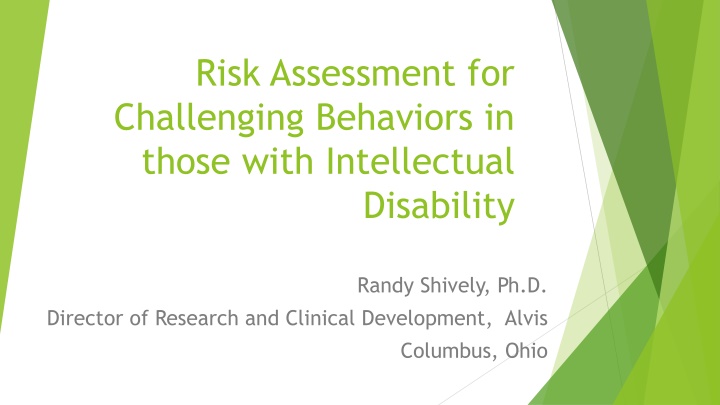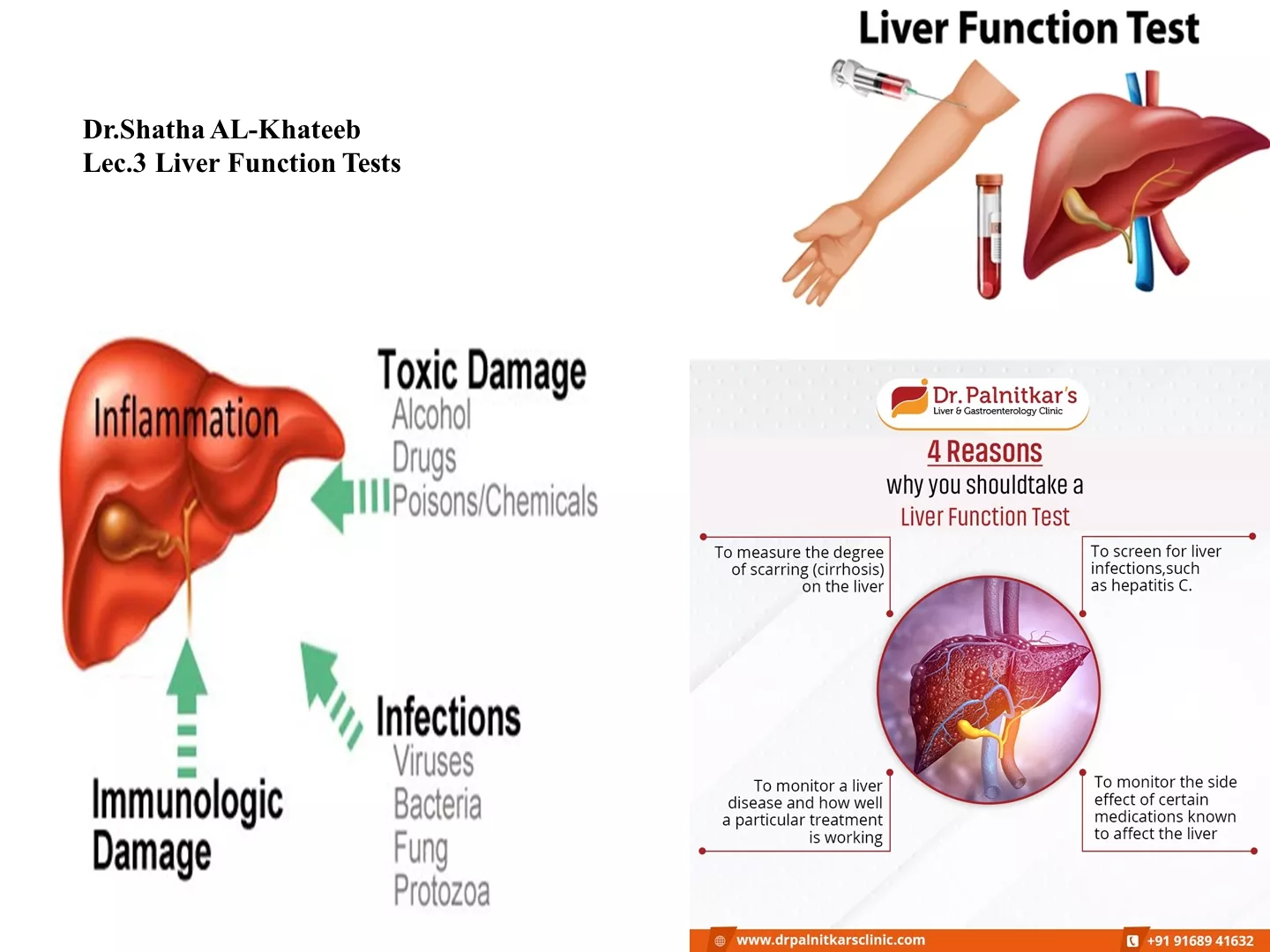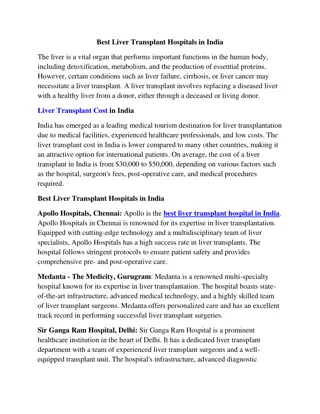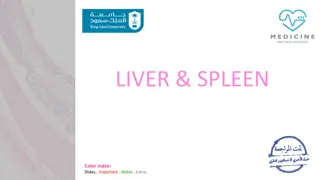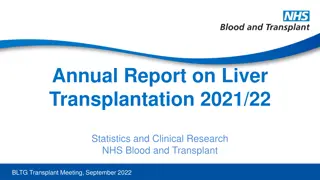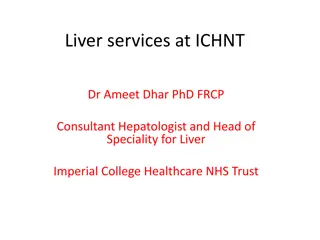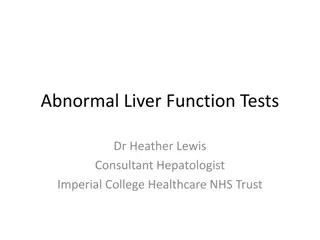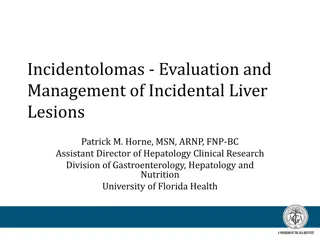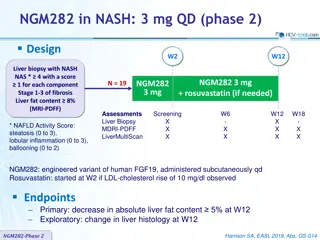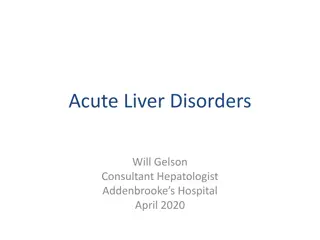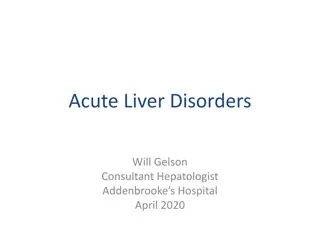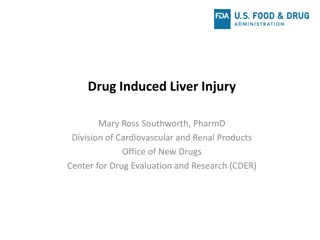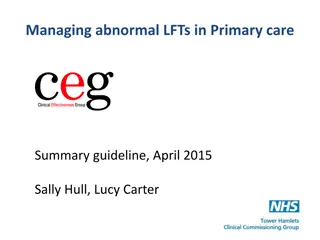Liver and Spleen Anatomy
This content provides comprehensive details on the anatomy of the liver and spleen, including their locations, subdivisions, relations, peritoneal reflections, blood supply, nerve supply, and lymphatic drainage. Detailed insights on the liver's structure, surfaces, and peritoneal coverings are presented with clear illustrations. Aiming to enhance the understanding of medical students, the material covers key aspects essential for a solid grasp of liver and spleen anatomy.
Download Presentation

Please find below an Image/Link to download the presentation.
The content on the website is provided AS IS for your information and personal use only. It may not be sold, licensed, or shared on other websites without obtaining consent from the author.If you encounter any issues during the download, it is possible that the publisher has removed the file from their server.
You are allowed to download the files provided on this website for personal or commercial use, subject to the condition that they are used lawfully. All files are the property of their respective owners.
The content on the website is provided AS IS for your information and personal use only. It may not be sold, licensed, or shared on other websites without obtaining consent from the author.
E N D
Presentation Transcript
Risk Assessment for Challenging Behaviors in those with Intellectual Disability Randy Shively, Ph.D. Director of Research and Clinical Development, Alvis Columbus, Ohio
Quotes He who is not courageous enough to take risks will accomplish nothing in life Mohammad Ali Living with fear stops us taking risks, and if you don t go out on the branch, you re never going to get the best fruit Sarah Parish
Supervision like risk should be a dynamic, fluid concept Needs to regularly be evaluated Needs to be least restrictive Needs to promote safety Needs to be faded as appropriate skills are taught
When to do a risk assessment? Client has a pattern of unstable, potentially harmful behaviors to self or others Question of whether restrictive measures are still necessary to protect client/others from harm Life circumstances have changed which could directly impact risk, ie. death of loved one, trauma, major health issue, charged with crime Environment(s) of client have changed recently and questions of risk
Ask Specific Questions in Referral for Risk Assessment Environment- How close does supervision need to be at home? In Community? At work? Type of Supervision- Does client need visual, arms length, auditory supervision? Risk Level- What level of risk does ___ present in community? In the home? In the work setting?
Team Importance with Risk/Supervision An effective team produces a support plan with supervision guidelines which are more comprehensive and creative than any one person on the team could produce independently. The team has the responsibility to monitor the effectiveness of the plan and meet frequently enough to make well thought out changes which balances the independence of the individual with the safety of the community Randy Shively
Increased Risk of Sex Offending Adjudicated individuals with intellectual disability and problematic sexual behaviors offer percentages 10-15 times higher than suggested by normal distribution - Petersilia, 2000; Guay 2005 It is estimated that up to a third or more of the total number of individuals with adjudicated sexual offense histories also have an intellectual disability - Jones, 2007
Why more sex offenses? Fewer dating opportunities Belief in ID world that those with cognitive delays are asexual Less tolerance of sexual deviance in community Poor social skills-poor decision making
Sex Offender Facts Percentage of Sex Offenders who will commit another sex offense- 2.7% Percentage of Sex Offenders who will commit another crime- 70% Percentage of sexual offenses that occur while living in a supervised setting- 60% NCMEC, 2013
DD Sex Offenders in Treatment Underage victims- Pedophilia and poor discrimination of age Impulsive in general- violate rules and people impulsively Anger/control/rape- retaliation or control of others drives their offending Pornography- internet violations
Clinician Adaptations Use simple vocabulary words Create short sentences Ask one question at a time Wait for an answer before proceeding Confirm client understood question
Requires Specialized Testing Assess intellectual challenges looking closely at literacy, problems with memory, problems with expressive and receptive language and social abilities Reduce reliance on verbal materials and processes Evaluate knowledge and education needs in all aspects of life but specifically sexuality Evaluate external/environmental factors exerting influence on the individual Blasingame, et al 2014
Staff Response to Brain Damage Repetition of requests Concreteness in giving requests Multiple senses to teach, ie. taste, smell, touch, see, hear Patience, patience, patience
Risk Principle- Risk, Need , Responsivity Model- Andrews and Bonta Target those offenders with higher probability of recidivism Provide more intense services to higher-risk offenders- more dosage hours- cognitive/behavioral Targeting lower risk offenders can lead to increases in recidivism rates University of Cincinnati Research
Ohio Risk Assessment System- ORAS Need Areas Family/Marital Accommodation Companions Alcohol/Drug Problems Emotional/Personal Antisocial/Criminal Attitudes
Model for Risk Assessment 1. Intellectual Disability- How does it impact risk? Impulsivity, verbal comprehension, memory, perceptual reasoning, processing speed? 2. Mental Health- Medication compliance? Diagnoses accurate?; Reality testing- delusion and/or hallucination? Does decompensation precede risk incidents? 3. Offending Behavior- Risk areas? What are Static and Dynamic risk predictors? What is needed supervision level? What settings present greatest risk? Does direct staffing impact risk? Randy Shively, Ph.D.
Case Study #1 IQ of 67-age 45 Diagnoses of Pedophilia, Foot Fetish and Major Depression Molested reported 50 boys in a small town-solicited victims by volunteering at little league and children s camps Lives in Supported Living with arms length supervision in community and Bathroom Monitoring Still plays a lot of manipulative games and will tries and defy and argue with staff/authority Still tries to access children s materials at work-cycle of admitting and denying attraction to boys
Case Study #2 Age 60; IQ of 105 Diagnosed with Aspergers, Alcohol Use Disorder, moderate and Recurrent Depression Passive, lonely man with addiction to pornography Numerous charges of downloading underage pornography- 5 years in prison History of Alcohol binging and cutting on self Restricted to staff supervision when on internet, only uses laptop during day No computer access at work due to losing job looking up pornography
Observed Risk Issues Often anger and sex get paired- emotions difficult to manage in our population Physical aggression becomes a way to gain control in an uncomfortable/misunderstood situation Passive individuals who bury their anger can act it out in aggression and/or fire setting- revenge Aggression can be linked to medication/biochemical imbalances or MH episodes
Goal is to Manage Risk PREDICTION OF WHO IS GOING TO ACT OUT AND IN WHAT WAY IS POOR: THE KEY IS LOOKING FOR EFFECTIVE WAYS TO MANAGE RISK FACTORS. EFFECTIVE RISK ASSESSMENT IS ONE IMPORTANT TOOL
Risk Information for County Boards Risk Evaluation by Licensed Professional Behavior Assessment Report Restrictions and Strategies contained in Individual Program Plans (IPP) Service Coordinator create Restrictive Measures and target fades
Behavior Modification We must create an environment that is geared towards consistent reinforcement of positive or pro-social skills that compete with offending behaviors . This may mean a culture change. In changing our environment by reinforcing prosocial behavior on a regular basis, we will find ourselves having to punish less and create a more positive environment for our staff and clients to work in.
Meaningful interactions with intellectually disabled clients is the foundation they need to trust the change process!
High Quality Relationships Improve Likelihood of Behavior Change Behavior is reinforced through environmental cues Demonstrate respect Demonstrate enthusiasm Demonstrate concern Teach Reward Punish only when necessary Professional rapport with individual is also key when assessing individual!
Sexual Disorders: Assessment Due to limited verbal skills difficult to express sexuality People with ID limited sexual knowledge and/or experience Sexuality Needs have been ignored historically ID individuals seen as asexual Ertophobia (negative fears to explore sexuality)
Promising Instruments Socio-sexual Knowledge and Attitudes Assessment Tool- Revised (Griffiths and Lunsky)-2003 Identifies with concrete pictures the understanding and preferences in the areas of : Anatomy, Men s and Women s Bodies, Intimacy, Pregnancy, Birth Control, Healthy Boundaries
Promising Instruments Assessment of Risk and Manageabilty of Individuals with Developmental and Intellectual Limitations who Sexually Offend (ARMIDILO-S) Boer et al, 2012 Stable items: supervision compliance, treatment compliance, sexual deviance, sexual preoccupations, emotional coping, relationships, impulsivity, substance abuse, mental health
ARMIDILLO-R: Acute Acute items: changes in client s compliance with supervision and treatment; changes in sexual preoccupation, changes in victim-related behaviors, changes in emotional coping, changes in the use of coping strategies, changes in monitoring, changes in social relationships, situational changes, changes in victim access
Deviance or Disability? Are the behaviors being assess representative of a sexual pathology (paraphilia) or are they symptomatic of environmental factors and/or poor understanding of sexual situations and social consequences? Labeling someone sexually deviant can be a life sentence!
Assessing Paraphilias: Questions Is the behavior (problems) part of a preferred sexual pattern? Are the behaviors present when there is no active mental health disorder? Is the behavior(s) part of a recurrent pattern? Was the onset earlier in life?
Promising Instrument Phenix and Sreenivasan (2009) list of DD specific risk factors Social skills deficits; Committing violent offenses; being unemployed; psychiatric history; substance use disorder; easily susceptible to the influence of others; history of delinquency; poor response to treatment; antisocial attitude; low self-esteem; impulsivity to sexual acting out; high static risk
Client Lacks Understanding of Risk Providers need to educate on: - Natural Consequences - Social Impact -Thinking Errors
QUESTIONS TO ASK DD CLIENTS What do you have to lose by continuing the risky behavior? What do you have to gain by learning socially appropriate behaviors? Are you aware of how your behavior impacts others?
QUESTIONS TO ASK CLIENTS Do you intend to change your behavior(s)? Do you want to be supervised more closely? What is your motivation for engaging in the behavior? How are staff helping or hindering you in changing your behavior(s)?
STAFF VIEW OF RISK Where can I safely take the client? Where can I not safely take the client? Who is the client safe to be around? Who is the client not safe to be around?
STAFF VIEW OF RISK Which staff does the client work well with client? Which staff does the client not work well with client? What do I not know about the client related to their risk? What triggers the client acting out? What would I do if the worst risk issue occurs?
STAFF VIEW OF RISK How do I supervise the client at home? How do I supervise the client in the community/work setting? Who do I give information to and how do I report it if the client is not cooperating or does something risky when I am supervising?
STAFF VIEW OF RISK Do I feel safe working with this client? If not what are my options? What is the worst thing this client has ever done? Under what circumstances did the behavior(s) occurred? What makes the client feel safe? What makes the client feel unsafe?
Team Monitors and Regulates Safety Community Access Media Access Supervision Levels Daily Living Skills/Activities of Daily Living
Understanding Offense Cycle Triggers set off the process of offending. Sex offenses are planned Culmination of a series of events (ie. planning/grooming) Offending behaviors are sometimes rationalized and planned (ie. thinking errors)
Adapted Offense Cycle Thought Blockers
TEACHING KEY SKILLS Interpersonal Skills : Boundaries/internal and external controls/accepting supervision Conflict Resolution Intimacy Pro-Social Behaviors Individual Attributes Self-control and Behavior Regulation Self-confidence Empathy
Cognitive Strategies TOC-Think of Consequences TOP- Think of other People CAP- Consent, Age Appropriate, Privacy Thinking for a Change
Philosophy of DBT DBT is: Dialectical-opposite responding to negatives Supportive Cognitive Behavioral Skill oriented Balances acceptance and change Requires a collaborative relationship All the features of a therapy well suited to people with learning disabilities
